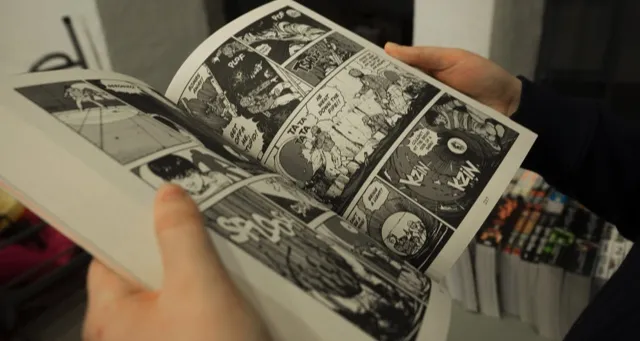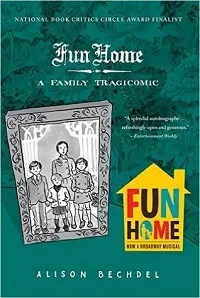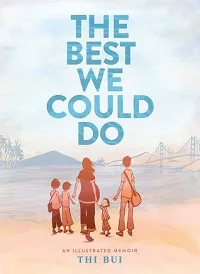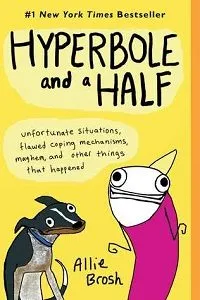
Read Harder: Read a Graphic Memoir
This content contains affiliate links. When you buy through these links, we may earn an affiliate commission.
This list of graphic memoirs for the 2020 Read Harder Challenge is sponsored by TBR: Tailored Book Recommendations.
 TBR is Book Riot’s subscription service offering Tailored Book Recommendations for readers of all stripes. Been dreaming of a “Stitch Fix for books?” Now it’s here! Tell TBR about your reading preferences and what you’re looking for, and sit back while your Bibliologist handpicks recommendations just for you. TBR offers plans to receive hardcover books in the mail or recommendations by email, so there’s an option for every budget. Visit mytbr.co to sign up today.
TBR is Book Riot’s subscription service offering Tailored Book Recommendations for readers of all stripes. Been dreaming of a “Stitch Fix for books?” Now it’s here! Tell TBR about your reading preferences and what you’re looking for, and sit back while your Bibliologist handpicks recommendations just for you. TBR offers plans to receive hardcover books in the mail or recommendations by email, so there’s an option for every budget. Visit mytbr.co to sign up today.
Graphic memoirs! While a written memoir can get into the minutiae of a person’s life and experience, the graphic format allows for a different expression of feeling, tone, and memory. The genre spans a huge range and no matter your area of interest, there is more than likely a graphic memoir that will fit it. Below is a list of nine. You can check out something that immediately grabs your attention, or maybe push yourself and read about a life you might not otherwise have taken a look at. See these as a jumping-off point for an exciting and expanding genre of nonfiction.
A true classic of the graphic memoir genre! Fun Home explores Bechdel’s coming out, her relationship with her closeted father, and her life growing up in rural Pennsylvania. TW for suicide.
What defines being a girl? Liz Prince’s memoir looks at her youth and teen years as she struggles to figure out her identity. When you don’t fit into the culturally set markers for your gender, what do you do? Prince explores this while taking a long look at her thoughts (thinking she hated girls) and behaviors at the time.
Forney was diagnosed with bipolar disorder directly before her 30th birthday. Her memoir chronicles her attempts to figure out what defines her creativity, if her medication is stunting it or helping it, and how she wants to move forward. Scattered throughout are looks at other artists diagnosed with mood disorders throughout history, and a deeper dive into the clinical background of bipolar disorder.
Sattouf chronicles his life growing up under multiple dictatorial regimes in the Middle East. While dealing with the constant uprooting of his family, he also grapples with his relationship with his father, whose “grandiose dreams for the Arab nation” cause him to bring his family from France to Libya to Syria.
The Best We Could Do is beautiful and evocative as Thi Bui recounts becoming a mother while looking back to her family’s immigration to America from South Vietnam in the 1970s. Pulitzer Prize–winning novelist Viet Thanh Nguyen calls it “a book to break your heart and heal it.”
Michelle Obama calls Geoffrey Canada “one of my heroes.” Jamar Nicholas adapts his story of growing up in the South Bronx for the graphic memoir genre to stunning and poignant effect. There, you were ranked through the ritual of fist, stick, knife, and then a gun as the final step.
Glidden recounts her trip as a “progressive Jewish American” to Israel, where she arrives with some strong opinions and finds from her conversations that the situation is far more complicated than she could see from afar.
Allie Brosh’s deceptively simple drawings communicate a world of emotion, depth, and hilarity as she deals with her very challenging dogs, childhood love of sugar, and her at times incapacitating depression.
Much like Fun Home, you almost HAVE to include Persepolis in a list of graphic memoirs. Swiftly a modern classic, this narrative tells Satrapi’s story of her life in Tehran from ages 6 to 18, a time that encompassed the overthrow of the Shah and the “triumph of the Islamic Revolution.” Rendered in black and white, her images remain with you, as well as her retelling of the history of Iraq. This is a must-read.
Find all the Read Harder 2020 content here.
 TBR is Book Riot’s subscription service offering Tailored Book Recommendations for readers of all stripes. Been dreaming of a “Stitch Fix for books?” Now it’s here! Tell TBR about your reading preferences and what you’re looking for, and sit back while your Bibliologist handpicks recommendations just for you. TBR offers plans to receive hardcover books in the mail or recommendations by email, so there’s an option for every budget. Visit mytbr.co to sign up today.
TBR is Book Riot’s subscription service offering Tailored Book Recommendations for readers of all stripes. Been dreaming of a “Stitch Fix for books?” Now it’s here! Tell TBR about your reading preferences and what you’re looking for, and sit back while your Bibliologist handpicks recommendations just for you. TBR offers plans to receive hardcover books in the mail or recommendations by email, so there’s an option for every budget. Visit mytbr.co to sign up today.
Graphic memoirs! While a written memoir can get into the minutiae of a person’s life and experience, the graphic format allows for a different expression of feeling, tone, and memory. The genre spans a huge range and no matter your area of interest, there is more than likely a graphic memoir that will fit it. Below is a list of nine. You can check out something that immediately grabs your attention, or maybe push yourself and read about a life you might not otherwise have taken a look at. See these as a jumping-off point for an exciting and expanding genre of nonfiction.
 Fun Home by Alison Bechdel
Fun Home by Alison Bechdel
A true classic of the graphic memoir genre! Fun Home explores Bechdel’s coming out, her relationship with her closeted father, and her life growing up in rural Pennsylvania. TW for suicide.
 Tomboy by Liz Prince
Tomboy by Liz Prince
What defines being a girl? Liz Prince’s memoir looks at her youth and teen years as she struggles to figure out her identity. When you don’t fit into the culturally set markers for your gender, what do you do? Prince explores this while taking a long look at her thoughts (thinking she hated girls) and behaviors at the time.
 Marbles: Mania, Depression, Michelangelo, and Me by Ellen Forney
Marbles: Mania, Depression, Michelangelo, and Me by Ellen Forney
Forney was diagnosed with bipolar disorder directly before her 30th birthday. Her memoir chronicles her attempts to figure out what defines her creativity, if her medication is stunting it or helping it, and how she wants to move forward. Scattered throughout are looks at other artists diagnosed with mood disorders throughout history, and a deeper dive into the clinical background of bipolar disorder.
 The Arab of the Future: A Childhood in the Middle East, 1978–1984 by Riad Sattouf
The Arab of the Future: A Childhood in the Middle East, 1978–1984 by Riad Sattouf
Sattouf chronicles his life growing up under multiple dictatorial regimes in the Middle East. While dealing with the constant uprooting of his family, he also grapples with his relationship with his father, whose “grandiose dreams for the Arab nation” cause him to bring his family from France to Libya to Syria.
 The Best We Could Do by Thi Bui
The Best We Could Do by Thi Bui
The Best We Could Do is beautiful and evocative as Thi Bui recounts becoming a mother while looking back to her family’s immigration to America from South Vietnam in the 1970s. Pulitzer Prize–winning novelist Viet Thanh Nguyen calls it “a book to break your heart and heal it.”
 Fist Stick Knife Gun by Geoffrey Canada
Fist Stick Knife Gun by Geoffrey Canada
Michelle Obama calls Geoffrey Canada “one of my heroes.” Jamar Nicholas adapts his story of growing up in the South Bronx for the graphic memoir genre to stunning and poignant effect. There, you were ranked through the ritual of fist, stick, knife, and then a gun as the final step.
 How to Understand Israel in 60 Days or Less by Sarah Glidden
How to Understand Israel in 60 Days or Less by Sarah Glidden
Glidden recounts her trip as a “progressive Jewish American” to Israel, where she arrives with some strong opinions and finds from her conversations that the situation is far more complicated than she could see from afar.
 Hyperbole and a Half by Allie Brosh
Hyperbole and a Half by Allie Brosh
Allie Brosh’s deceptively simple drawings communicate a world of emotion, depth, and hilarity as she deals with her very challenging dogs, childhood love of sugar, and her at times incapacitating depression.
 Persepolis by Marjane Satrapi
Persepolis by Marjane Satrapi
Much like Fun Home, you almost HAVE to include Persepolis in a list of graphic memoirs. Swiftly a modern classic, this narrative tells Satrapi’s story of her life in Tehran from ages 6 to 18, a time that encompassed the overthrow of the Shah and the “triumph of the Islamic Revolution.” Rendered in black and white, her images remain with you, as well as her retelling of the history of Iraq. This is a must-read.
Find all the Read Harder 2020 content here.


